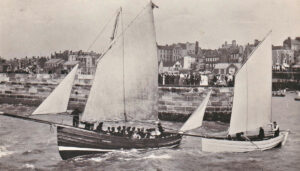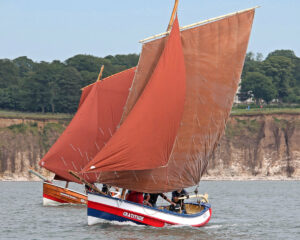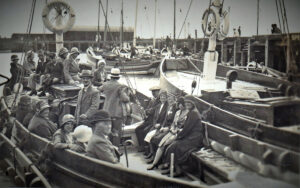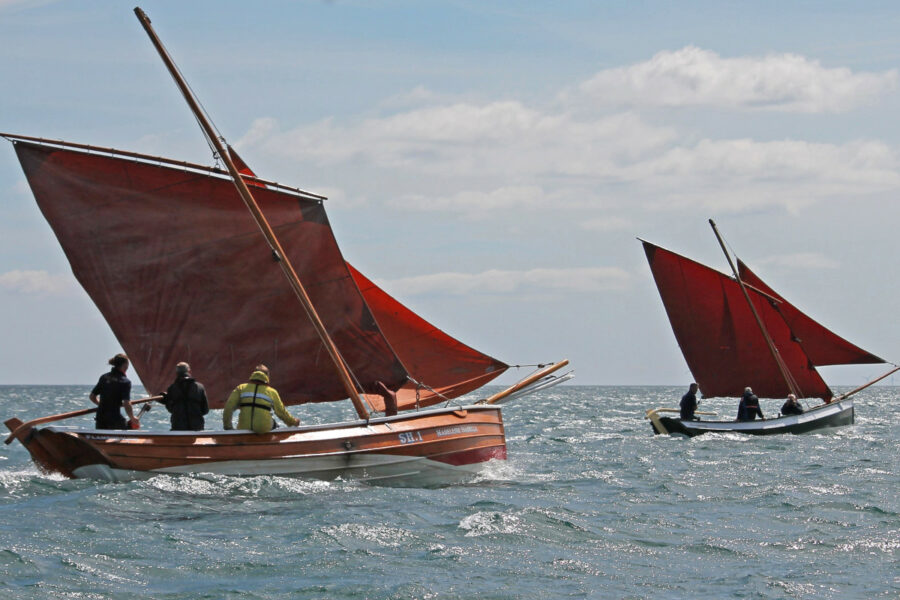At the turn of the 20th century, the town of Bridlington, East Yorkshire, had developed into a popular seaside resort, like many others around the coastline of Britain.
Postcards from that era show the promenades and harbour piers thronged with hundreds of visitors, many of them eager to take a boat trip out to sea.
The local boat owners and fishermen knew this, and were keen to oblige, with a trip out into the beautiful Bridlington Bay being offered on their sailing cobles. The coble, the traditional inshore working boat of the northeast coast of England, mention of which can be traced back to the Lindisfarne Gospels, was an ideal vessel for this purpose. The visitors were also a great source of additional income during the summer months for most of the local fishermen.

Bridlington sailing cobles, leaving harbour to take visitors for a sail in the bay. (Photos: Paul L Arro and postcard collection of Paul L Arro)
Sailing cobles at Bridlington were quite unique, compared to those seen at other harbours and ports on the Yorkshire coast. Although rigged in exactly the same manner, with dipping lug and fore sails, the Bridlington cobles were big. At 38-40ft in length, their passenger-carrying capacity was enormous. Old postcards depict these cobles packed with passengers, long before the days of health and safety issues.
All these big cobles had been locally built in Bridlington by the Siddall boat-building family – Baker, his son Percy and grandson Jack – or at Flamborough by the Hopwood family, Robert Moore and his son Hargrave Potter – a name that would become acclaimed in later years as one of the doyen coble-builders.
A trip around the bay on the sailing cobles and the paddle steamers was very much part of the traditional seaside holiday. In fact, it was still very popular in the 1930s, when motor power had succeeded sail, and the bigger motor pleasure boats had arrived on the scene to replace the paddle steamers.
Bridlington harbour was full of sailing cobles in those distant days, and what a truly magnificent sight they made with their gleaming white hulls and contrasting cream- or tan-coloured sails. One would not have thought those glorious sailing days would ever end, but with the development of motor engines just after the First World War, they did.
Slowly but surely, sail gave way to motor, and engines were fitted in the cobles. The pleasure trips around the bay continued with the cobles under power, but gradually that passenger trade moved to the larger motor steamers, which were advertising much longer trips around the magnificent Flamborough Head and beyond.

Bridlington coble Friends leaving the harbour behind.
However, daily angling parties were now a steady income for the motor coble skippers, who would take rod and line fishermen out across the bay, and to just off Flamborough Head. Sadly, that all virtually came to a close in the mid 1980s, although a small number of angling boats still ply that trade even today.
The Bridlington harbour commissioners had some foresight of the decline of the traditional local cobles, and in 1983, they bought Three Brothers for restoration. Built in 1912 by Baker and Percy Siddall in their Bow Street workshop, the vessel was completely stripped, rebuilt, and rigged for sail once again.
All this work was carried out under the supervision of George Wallis, the then harbour master, and Frank Taylor, the harbour shipwright. The boat was handed over into the care of the Bridlington Sailing Coble Preservation Society (BSCPS), which had been formed in 1983 to preserve, maintain and sail it.
That society now has a growing number of members and, indeed, has gone from strength to strength in recent years. In 2015, it purchased the sailing coble Gratitude, built in 1976 by Hector Handyside, the works foreman and master coble builder at J & J Harrison, Amble. The society then bought Gansey Lass in 2017, one of two sailing cobles built by John Clarkson and Joe Gelsthorpe at Bridlington in 2014. Standard membership of the BSCPS is just £5 a year, or £15 for sailing membership. All three cobles are regularly sailed at weekends, subject to tides and weather conditions.

Madeleine Isabella and Gratitude performing well during the 2017 Sailing Coble Festival.
The idea was floated in 2015, by two or three coble enthusiasts, of trying to organise a gathering of sailing cobles at Bridlington. There had been an increased interest in sailing cobles generally, and as well as those sailed by the BSCPS, there were two privately owned cobles at that time in Bridlington harbour, Madeleine Isabella and Imperialist – now increased to four with the addition of Bethany of Bridlington and Free Spirit – together with a small number in different areas of the country. Early in 2016, that initial idea was built upon and, with the full co-operation of the harbour commissioners, the very first Bridlington Sailing Coble Festival took place over the weekend of 13-14 August that year.
It proved to be such a resounding success that a second festival was held in 2017. Those two events generated so much interest along the northeast coast, from East Yorkshire to North Northumberland, that it was decided to make it an annual event on the maritime calendar, and a further festival was organised in 2018.
Visiting sailing cobles came from Mevagissey (Christina), South Shields (Royal Diadem II), Henley on Thames (Avail) and Staithes (Grace). The beautiful clinker-built keelboat Granby was present, together with the Tyne workboat Rose, rigged for sail. The 73ft replica of the twin-masted top-sail schooner HMS Pickle was anchored in the bay over the weekend, a nostalgic sight enjoyed by all those who attended.

Passengers ready for a sail on Speedwell.
The 2019 Sailing Coble Festival will take place at Bridlington over the weekend of 27-28 July. Initial planning of the event is now well underway, and early indications are that it will see the largest gathering in living memory. Fortunately, with increased interest in cobles – the mainstay of the inshore fishing industry for many generations – there are a number of restoration projects already in hand. Once completed, these will increase the number of sailing cobles available in future years.
The nostalgic vista of beautiful, traditional craft once again sailing out of Bridlington harbour is a sight not to be missed. Those bygone images depicted in old photographs and postcards will be brought back to life for the two days of the festival. Anyone with an interest in the maritime heritage of the northeast of England should not miss the opportunity to witness this truly magnificent event. Nowhere else in Great Britain can such a gathering of traditional sailing cobles be seen. Bridlington on the East Yorkshire coast has become the sailing coble capital of Britain.








